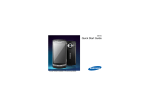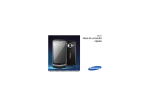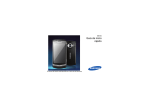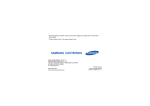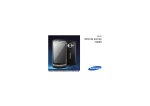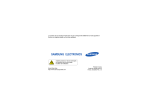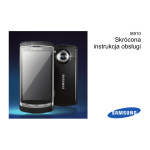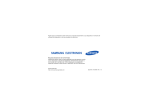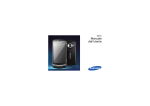Download Samsung GT-I8910/M16 User Manual
Transcript
Some of the contents in this guide may differ from your device depending on the software of the device or your service provider. World Wide Web http://www.samsungmobile.com Printed in Korea Code No.:GH68-22348A English (EU). 05/2009. Rev. 1.1 I8910 Quick Start Guide The user manual is available on the Samsung website. Instructional icons using this manual Before you start, familiarise yourself with the icons you will see in this manual: Warning—situations that could cause injury to yourself or others This quick start guide has been specially designed to guide you through the functions and features of your device. Caution—situations that could cause damage to your device or other equipment Note—notes, usage tips, or additional information X 2 Refer to—pages with related information; for example: X p. 12 (represents "see page 12") Copyrights and trademarks → [ ] Followed by—the order of options or menus you must select to perform a step; for example: In Menu mode, select Messaging → New message (represents Messaging, followed by New message) Square brackets—device keys; for example: [ ] (represents the End/ Power key). Rights to all technologies and products that comprise this device are the property of their respective owners: • This product includes software licensed from Symbian Ltd. © 1998-2009. Symbian and Symbian OS are trademarks of Symbian Ltd. • Java™ is a trademark of Sun Microsystems, Inc. • Bluetooth® is a registered trademark of the Bluetooth SIG, Inc. worldwide. Bluetooth QD ID: B015049 • Windows Media Player® is a registered trademark of Microsoft Corporation. 3 • Wi-Fi®, the Wi-Fi CERTIFIED logo, and the Wi-Fi logo are registered trademarks of the Wi-Fi Alliance. • DivX® is a registered trademark of DivX, Inc., and is used under licence. ABOUT DIVX VIDEO DivX® is a digital video format created by DivX, Inc. This is an official DivX Certified device that plays DivX video. Visit www.divx.com for more information and software tools to convert your files into DivX video. Devices certified to play DivX® video at the Mobile Theater profile: DivX Certified to play DivX® video up to 640x480, including premium content. ABOUT DIVX VIDEO-ON-DEMAND This DivX Certified® device must be registered in order to play DivX Video-on-Demand (VOD) content. To generate the registration code, locate the DivX VOD section in the device setup menu. Go to vod.divx.com with this code to complete the registration process and learn more about DivX VOD. 4 safety and usage information Comply with the following precautions to avoid dangerous or illegal situations and ensure peak performance of your device. Safety warnings Keep your device away from small children and pets Keep your device and all accessories out of the reach of small children or animals. Small parts may cause choking or serious injury if swallowed. Protect your hearing Listening to a headset at high volumes can damage your hearing. Use only the minimum volume setting necessary to hear your conversation or music. 5 Install mobile devices and equipment with caution Ensure that any mobile devices or related equipment installed in your vehicle are securely mounted. Avoid placing your device and accessories near or in an air bag deployment area. Improperly installed wireless equipment can cause serious injury when air bags inflate rapidly. Handle and dispose of batteries and chargers with care • Use only Samsung-approved batteries and chargers specifically designed for your device. Incompatible batteries and chargers can cause serious injuries or damage to your device. • Never dispose of batteries or devices in a fire. Follow all local regulations when disposing used batteries or devices. 6 • Never place batteries or devices on or in heating devices, such as microwave ovens, stoves, or radiators. Batteries may explode when overheated. Avoid interference with pacemakers Maintain a minimum of 15 cm (6 inches) between mobile devices and pacemakers to avoid potential interference, as recommended by manufacturers and the independent research group, Wireless Technology Research. If you have any reason to suspect that your device is interfering with a pacemaker or other medical equipment, turn off the device immediately and contact the manufacturer of the pacemaker or medical equipment for guidance. Do not use the phone if the screen is cracked or broken Broken glass could cause injury to your hand and face. Bring the phone to Samsung service centre to replace the glass. Turn off the device in potentially explosive environments Do not use your device at refuelling points (service stations) or near fuels or chemicals. Turn off your device whenever directed by warning signs or instructions. Your device could cause explosions or fire in and around fuel or chemical storage and transfer areas or blasting areas. Do not store or carry flammable liquids, gases, or explosive materials in the same compartment as the device, its parts, or accessories. Reduce the risk of repetitive motion injuries While using your device, hold the device with a relaxed grip, press the keys lightly, use special features that reduce the number of keys you have to press (such as templates and predictive text), and take frequent breaks. Safety precautions Drive safely at all times Avoid using your device while driving and obey all regulations that restrict the use of mobile devices while driving. Use hands-free accessories to increase your safety when possible. Follow all safety warnings and regulations Comply with any regulations that restrict the use of a mobile device in a certain area. Use only Samsung-approved accessories Using incompatible accessories may damage your device or cause injury. 7 Turn off the device near medical equipment Protect batteries and chargers from damage Your device can interfere with medical equipment in hospitals or health care facilities. Follow all regulations, posted warnings, and directions from medical personnel. • Avoid exposing batteries to very cold or very hot temperatures (below 0° C/32° F or above 45° C/113° F). Extreme temperatures can reduce the charging capacity and life of your batteries. • Prevent batteries from contacting metal objects, as this can create a connection between the + and - terminals of your batteries and lead to temporary or permanent battery damage. • Never use a damaged charger or battery. • Risk of explosion if a battery or device is replaced by an incorrect type. Dispose of used batteries or devices according to the instructions. Turn off the device or disable the wireless functions when in an aircraft Your device can cause interference with aircraft equipment. Follow all airline regulations and turn off your device or switch to a mode that disables the wireless functions when directed by the airline personnel. 8 Handle your device carefully and sensibly • Do not allow your device to get wet—liquids can cause serious damage. Do not handle your device with wet hands. Water damage to your device can void your manufacturer’s warranty. • Avoid using or storing your device in dusty, dirty areas to prevent damage to moving parts. • Your device is made of complex electronics—protect it from impacts and rough handling to avoid serious damage. • Do not paint your device, as paint can clog moving parts and prevent proper operation. • If your device has a camera flash or light, avoid using it close to the eyes of children or animals. • Your device may be damaged by exposure to magnetic fields. Do not use carrying cases or accessories with magnetic closures or allow your device to come in contact with magnetic fields for extended periods of time. Avoid interference with other electronic equipment Your device emits radio frequency (RF) signals that may interfere with unshielded or improperly shielded electronic equipment, such as pacemakers, hearing aids, and medical equipment in homes or vehicles. Consult the manufacturers of your electronic equipment to solve any interference problems you experience. 9 Important usage information Use your device in the normal position Avoid contact with your device’s internal antenna. Allow only qualified personnel to service your device Allowing unqualified personnel to service your device may result in damage to your device and will void your warranty. Ensure maximum battery and charger life • Avoid charging batteries for more than a week, as overcharging may shorten battery life. • Over time, unused batteries will discharge and must be recharged before use. 10 • Disconnect chargers from power sources when not in use. • Use batteries only for their intended purpose. Handle SIM cards and memory cards with care • Do not remove a card while the device is transferring or accessing information, as this could result in loss of data and/or damage to the card or device. • Protect cards from strong shocks, static electricity, and electrical noise from other equipment. • Frequent writing and erasing will shorten the life span of memory cards. • Do not touch gold-coloured contacts or terminals with your fingers or metal objects. If dirty, wipe the card with a soft cloth. Ensure access to emergency services Emergency calls from your device may not be possible in some areas or circumstances. Before travelling in remote or undeveloped areas, plan an alternate method of contacting emergency services personnel. Specific Absorption Rate (SAR) certification information Your device conforms to European Union (EU) standards that limit human exposure to radio frequency (RF) energy emitted by radio and telecommunications equipment. These standards prevent the sale of mobile devices that exceed a maximum exposure level (known as the Specific Absorption Rate, or SAR) of 2.0 watts per kilogram. During testing, the maximum SAR recorded for this model was 0.426 watts per kilogram. In normal use, the actual SAR is likely to be much lower, as the device has been designed to emit only the RF energy necessary to transmit a signal to the nearest base station. By automatically emitting lower levels when possible, your device reduces your overall exposure to RF energy. The Declaration of Conformity at the back of this manual demonstrates your device’s compliance with the European Radio & Terminal Telecommunications Equipment (R&TTE) directive. For more information about the SAR and related EU standards, visit the Samsung mobile website. 11 Correct disposal of this product (Waste Electrical & Electronic Equipment) (Applicable in the European Union and other European countries with separate collection systems) This marking on the product, accessories or literature indicates that the product and its electronic accessories (e.g. charger, headset, USB cable) should not be disposed of with other household waste at the end of their working life. To prevent possible harm to the environment or human health from uncontrolled waste disposal, please separate these items from other types of waste and recycle them responsibly to promote the sustainable reuse of material resources. Household users should contact either the retailer where they purchased this product, or their local government office, for details of where and how they can take this item for environmentally safe recycling. Business users should contact their supplier and check the terms and conditions of the purchase contract. This product and its electronic accessories should not be mixed with other commercial wastes for disposal. This EEE is compliant with RoHS. 12 Correct disposal of batteries in this product (Applicable in the European Union and other European countries with separate battery return systems) This marking on the battery, manual or packaging indicates that the batteries in this product should not be disposed of with other household waste at the end of their working life. Where marked, the chemical symbols Hg, Cd or Pb indicate that the battery contains mercury, cadmium or lead above the reference levels in EC Directive 2006/66. If batteries are not properly disposed of, these substances can cause harm to human health or the environment. To protect natural resources and to promote material reuse, please separate batteries from other types of waste and recycle them through your local, free battery return system. Disclaimer Some content and services accessible through this device belong to third parties and are protected by copyright, patent, trademark and/ or other intellectual property laws. Such content and services are provided solely for your personal noncommercial use. You may not use any content or services in a manner that has not been authorised by the content owner or service provider. Without limiting the foregoing, unless expressly authorised by the applicable content owner or service provider, you may not modify, copy, republish, upload, post, transmit, translate, sell, create derivative works, exploit, or distribute in any manner or medium any content or services displayed through this device. “THIRD PARTY CONTENT AND SERVICES ARE PROVIDED "AS IS." SAMSUNG DOES NOT WARRANT CONTENT OR SERVICES SO PROVIDED, EITHER EXPRESSLY OR 13 IMPLIEDLY, FOR ANY PURPOSE. SAMSUNG EXPRESSLY DISCLAIMS ANY IMPLIED WARRANTIES, INCLUDING BUT NOT LIMITED TO, WARRANTIES OF MERCHANTABILITY OR FITNESS FOR A PARTICULAR PURPOSE. SAMSUNG DOES NOT GUARANTEE THE ACCURACY, VALIDITY, TIMELINESS, LEGALITY, OR COMPLETENESS OF ANY CONTENT OR SERVICE MADE AVAILABLE THROUGH THIS DEVICE AND UNDER NO CIRCUMSTANCES, INCLUDING NEGLIGENCE, SHALL SAMSUNG BE LIABLE, WHETHER IN CONTRACT OR TORT, FOR ANY DIRECT, INDIRECT, INCIDENTAL, SPECIAL OR CONSEQUENTIAL DAMAGES, ATTORNEY FEES, EXPENSES, OR ANY OTHER DAMAGES ARISING OUT OF, OR IN CONNECTION WITH, ANY INFORMATION CONTAINED IN, OR AS A RESULT OF THE USE OF ANY CONTENT OR SERVICE BY YOU OR ANY THIRD PARTY, EVEN IF ADVISED OF THE POSSIBILITY OF SUCH DAMAGES." 14 Third party services may be terminated or interrupted at any time, and Samsung makes no representation or warranty that any content or service will remain available for any period of time. Content and services are transmitted by third parties by means of networks and transmission facilities over which Samsung has no control. Without limiting the generality of this disclaimer, Samsung expressly disclaims any responsibility or liability for any interruption or suspension of any content or service made available through this device. Samsung is neither responsible nor liable for customer service related to the content and services. Any question or request for service relating to the content or services should be made directly to the respective content and service providers. Unpack quick start guide Check your product box for the following items: • • • • • • • Mobile device Battery Travel adapter (charger) Headset PC data cable Samsung PC Studio CD Quick Start Guide The items supplied with your device may vary depending on the software and accessories available in your region or offered by your service provider. You can obtain additional accessories from your local Samsung dealer. 15 Device layout The front of your device includes the following keys and features: Light/ Proximity sensor Front camera lens for video calls Volume key Speaker Earpiece The rear of your device includes the following keys and features: Mouthpiece for recording videos Flashbulb Touch screen End/Power key 16 Battery cover Camera key Memory card slot Menu key Rear camera lens Hold key Multifunction jack Talk key Headset jack Mouthpiece Speaker Internal antenna Keys Key Icons Function Make or answer a call; In Standby mode, retrieve recently dialled, missed, or received numbers Access Menu mode; Show all active applications (press and hold) Turn the device on and off (press and hold); In Standby mode, access the quick menu (press and hold); End a call; In Menu mode, return to Standby mode In Standby mode, adjust the device’s volume Lock or unlock the touch screen and keys In Standby mode, turn on the camera (press and hold); In Camera mode, take a photo or record a video Learn about the icons that appear on your display. Icon Definition Signal strength (GSM/GPRS network) Signal strength (UMTS network) Signal strength (HSDPA network) Alarm activated New text or multimedia message New voice mail message New email message Sending a message Call diverting active (if you have multiple lines, a number will indicate which line is diverted) Active phone line 2 Missed call 17 Icon Definition Bluetooth activated Assemble and prepare your device Stereo headset connected Get started by assembling and setting up your mobile device for its first use. Mono headset connected Connected to PC Keypad locked Memory card inserted Wireless LAN available Battery power level Install the SIM or USIM card and battery When you subscribe to a cellular service, you will receive a Subscriber Identity Module, or SIM card, with subscription details, such as your personal identification number (PIN) and optional services. To use UMTS or HSDPA services, you can purchase a Universal Subscriber Identity Module (USIM) card. 18 To install the SIM or USIM card and battery, 2. Insert the SIM or USIM card. 1. Remove the battery cover. If the device is on, press and hold [ turn it off. ] to • Place the SIM or USIM card in the device with the gold-coloured contacts facing down. • Without inserting a SIM or USIM card, you can use your device’s non-network services and some menus. 19 3. Insert the battery. Charge the battery Before using the device for the first time, you must charge the battery. 1. Open the cover to the multifunction jack on the side of the device. 2. Plug the small end of the travel adapter into the multifunction jack. 4. Replace the battery cover. With the triangle facing up Improperly connecting the travel adapter can cause serious damage to the device. Any damages by misuse are not covered by the warranty. 20 3. Plug the large end of the travel adapter into a power outlet. 4. When the battery is fully charged (the icon is no longer moving), unplug the travel adapter from the power outlet. 5. Unplug the travel adapter from the device. 6. Close the cover to the multifunction jack. About the low battery indicator When your battery is low, the device will emit a warning tone and a low battery message. The battery icon will also be empty and blinking. If the battery level becomes too low, the device will automatically power off. Recharge your battery to continue using your device. Insert a memory card (optional) To store additional multimedia files, you must insert a memory card. Your device accepts microSDTM memory cards up to 16 GB (depending on memory card manufacturer and type). 1. Open the cover to the memory card slot on the side of the device. 2. Insert a memory card with the label side facing up. 3. Push the memory card in the memory card slot until it locks in place. 21 Follow these steps when removing a memory card Carefully follow the steps below when removing a memory card to avoid data loss or damage to the memory card. 1. Press and hold [ ] and select Remove F: memory card. 2. Select Yes to confirm. 3. Open the cover to the memory card slot and gently push the memory card in until it disengages from the device. 4. Pull the memory card out of the memory card slot. 5. Select OK. If you must reboot the device to finish installing an application, do not remove the card until the reboot is complete. Otherwise, your application files may be corrupted or erased. 22 Turn on your device on and off To turn your device on, 1. Press and hold [ device. ] to turn on your 2. Follow the onscreen instructions to set the region, city, current time, and the date. Your device will automatically connect to the cellular network. To turn your device off, repeat step 1 above. Lock or unlock the device You can lock the touch screen and the keys to prevent any unwanted device operations. To lock or unlock, press the Hold key. Switch to the offline profile Use the touch screen By switching to the offline profile, you can use your device’s non-network services in areas where wireless devices are prohibited, such as aeroplanes and hospitals. Your device’s touch screen lets you easily select items or perform functions. Learn basic actions to use the touch screen. To switch to the offline profile, in Menu mode, select Settings → Personal → Profiles → Offline → Options → Activate. Follow all posted warnings and directions from official personnel when in areas where wireless devices are prohibited. For the optimal use of the touch screen, remove the screen protection film before using your device. • Select an icon to open a menu or launch an application. 23 • Drag your finger up or down to scroll through vertical lists. 24 • Drag your finger left or right to scroll through horizontal lists. Work with applications Switch applications Open applications or folders Your device allows you to multi-task by running multiple applications at the same time. 1. In Standby mode, select Menu or press the Menu key to access Menu mode. To switch from one active application to another, 2. Select an application or a folder. 1. Press and hold the Menu key to open a list of applications. • Depending on your region or service provider, default applications on your device may vary. • When you open some applications for the first time, installation may begin. Follow the on-screen instructions to install the application. You can also download installation files from www.samsungmobile.com. • While your device is connected to a PC for mass storage, you cannot open applications installed in the E: drive. • Refer to the user manual to learn more about applications on your device. 2. Scroll to an application and select it. Close applications To close the current application, press [ ]. To close an application that is running in the background, 1. Press and hold the Menu key to open a list of applications. 2. Scroll to an application and select . Depending on your region or service provider, closing active applications in the background may not be possible. 25 Use widgets Change the widgets Learn to use widgets on the toolbar. 1. In Menu mode, select Settings → Personal → Widgets → Widgets. Open the toolbar 2. Select the widgets you want to include to the toolbar and select Back. In Standby mode, select the arrow at the bottom left of the screen to open the toolbar. You can rearrange widgets on the toolbar or move them to the idle screen. Depending on your region or service provider, available widgets may vary. Move the widgets to the idle screen 1. Open the toolbar. 2. Drag a widget from the toolbar to the idle screen. You can position the widget anywhere on the screen. 26 Use widget packages Group your favourite widgets together as a widget package. To create a widget package, 1. In Standby mode, select a package box (1 to 3) at the top right of the idle screen. 2. Drag a widget from the toolbar to the idle screen. To open the package, select the corresponding box. You can open only one package at one time. Access help information Make a call Learn to access helpful information about your device. 1. In Standby mode, select Telephone and enter an area code and phone number. 1. In Menu mode, select Tools → Help. 2. Press [ ] to dial the number. For a video call, select Options → Call → Video call. 2. Enter the first few letters of the help topic you want to find. 3. Select a help topic to learn about an application or feature. 4. Scroll the screen to get more information. To return to the previous level, select Back. 3. To end the call, press [ ]. Answer a call 1. When a call comes in, press [ ]. Use basic call functions 2. For a video call, press [ ] and select Yes to allow the caller to see you via the front camera lens. Learn to make or answer calls and use basic call functions. 3. To end the call, press [ During a call, your device automatically locks the touch screen to prevent accidental inputs. To unlock, press the Hold key. ]. Adjust the volume To adjust the volume during a call, press the Volume key up or down. 27 View and dial missed calls Call an international number Your device will display calls you have missed on the display. To dial the number of a missed call, 1. In Standby mode, select Telephone and twice to insert the + character. 1. Select Show. 2. Scroll to the missed call you want to dial. 3. Press [ ] to dial. Call a contact from the phonebook Call a recently dialled number 1. In Standby mode, press [ list of recent numbers. 2. Enter the complete number you want to dial (country code, area code, and phone number), and then press [ ] to dial. ] to display a 2. Scroll to the number you want and press [ ] to dial. You can call numbers directly from the phonebook using stored contacts. X p. 31 1. In Menu mode, select Contacts. 2. Scroll to the number you want to dial and press [ ] to dial. 3. Select a number (if necessary). 28 Send and view messages Enter text Learn to send and view text (SMS) messages. Enter text and create messages or notes. Change the text input method Send a text message 1. In Menu mode, select Messaging → New message. 2. Select the recipient input field. 3. Enter a destination number and select 4. Select the text input field. 5. Enter your message and select . 6. Select Options → Send to send the message. . When you open the text input field, the virtual keypad appears. Select and select one of the following input methods for entering text: • Virtual keypad (Alphanumeric keypad) • Qwerty keyboard (Full screen QWERTY) • Handwriting method (Handwriting) Enter text using the virtual keypad 1. Change the text input method to Alphanumeric keypad. 2. Select the appropriate keys to enter text. • To change case or switch to Predictive mode or Number mode, select . • To switch to Symbol mode, select . 29 You can use the following text input modes: Mode Function ABC Select the appropriate virtual key until the character you want appears on the display. Predictive 1. Select the appropriate alphanumeric keys to enter an entire word. 2. When the word displays correctly, select 0 to insert a space. If the correct word does not display, select to select an alternate word. Number Select the appropriate virtual key to enter a number. Symbol Select the appropriate virtual key to enter a symbol. 30 Enter text using the qwerty keyboard 1. Change the text input method to Full screen QWERTY. 2. Select the appropriate keys to enter text. • To change case, select . • To switch to Number or Symbol mode, select . • To enter special characters, select . Enter text using the handwriting method 1. Change the text input method to Handwriting. 2. Write characters in the shaded writing area. • To enter numbers, select . • To enter symbols, select . View text messages To add a new contact on a SIM or USIM card: 1. In Menu mode, select Messaging → Inbox. 1. In Menu mode, select Contacts → Options → Settings → Contacts to display → SIM memory → OK. 2. Select a text message. Add and find contacts Learn the basics of using the phonebook feature. 2. Select Default saving memory → SIM memory → OK. 3. Select Back. 4. Select Options → New contact. 5. Enter contact information. Add a new contact To add a new contact in the device's memory: 6. When you are finished entering information, select Done to save the contact card. 1. In Menu mode, select Contacts → Options → New contact. Find a contact 2. Enter contact information. 1. In Menu mode, select Contacts. To insert additional information fields, select Options → Add detail → a field type. 2. Enter the first few letters of the name you want to find. 3. When you are finished entering information, select Done to save the contact card. 31 3. Select the contact’s name from the search list. Once you have found a contact, you can: • call the contact by pressing [ ] • edit the contact information by selecting Options → Edit Link your photos to contacts Learn to tag faces in your photos to make calls or send messages from photos. 5. Select OK → Link to phonebook → a contact → a number. The selected contact is linked to the photo. 6. When you are finished, select Done. Use basic camera functions Learn the basics to capture and view photos and videos. To link your photos to contacts, Capture photos 1. In Standby mode, drag your finger to the right to access the photo contact screen. 1. Press and hold the Camera key to turn on the camera. 2. Select Add → a photo → Select. 2. Rotate the device anti-clockwise to landscape view. 3. Select Edit → Add Area to add a tag to a person’s face. 4. Move or resize the rectangle on a face. 32 3. Aim the lens at the subject and make any adjustments. 4. Press the Camera key to take a photo. The photo is saved automatically. View photos Icon Function In Menu mode, select Gallery → Images & videos → a photo file. Focus mode Change the camera focus While viewing the photo, touch the screen and use icons to zoom in or out, send the photo, start a slideshow, and delete the photo. Exposure value Set the exposure value Quickview View captured images or video clips Use camera options From the viewfinder, select an icon and change options: Icon Function Shooting mode Change the shooting mode Scene Change the scene mode Resolution Change the resolution option Settings Change the camera settings Flash Turn the flash on or off Capture videos 1. Press and hold the Camera key to turn on the camera. 2. Rotate the device anti-clockwise to landscape view. 3. Select to switch to Recording mode. 4. Aim the lens at the subject and make any adjustments. 5. Press the Camera key to start recording. 6. Select or press the Camera key to stop recording. The video is saved automatically. 33 View videos Icon In Menu mode, select Gallery → Images & videos → a video file. During playback, touch the screen and use icons to zoom in or out, and control playback. Use camcorder options From the viewfinder, select an icon and change options: Icon Function Recording Change the recording mode mode 34 Quickview Function View captured images or video clips Use advanced camera functions Learn how to capture photos in various modes and customise camera settings. Capture photos by using options preset for various scenes 1. Press and hold the Camera key to turn on the camera. Resolution Change the resolution option 2. Rotate the device anti-clockwise to landscape view. Settings Change the camcorder settings 3. Select Flash Turn the flash on or off Exposure value Set the exposure value → a scene. 4. Make any necessary adjustments. 5. Press the Camera key to take a photo. Capture a series of photos 1. Press and hold the Camera key to turn on the camera. 2. Rotate the device anti-clockwise to landscape view. 3. Select → Continuous. 5. Press the Camera key to take the first photo. 6. Slowly move the device to a direction. The device captures the next photo automatically. 7. Repeat step 6 to complete the panoramic photo. 4. Make any necessary adjustments. 5. Press and hold the Camera key to take a series of photos. Capture panoramic photos 1. Press and hold the Camera key to turn on the camera. 2. Rotate the device anti-clockwise to landscape view. 3. Select → Panorama. 4. Make any necessary adjustments. Capture photos in Smile shot mode 1. Press and hold the Camera key to turn on the camera. 2. Rotate the device anti-clockwise to landscape view. 3. Select → Smile shot. 4. Press the Camera key. 5. Aim the camera lens at your subject. Your device recognises people in an image and detects their smiles. When the subject smiles, the device automatically takes a photo. 35 Capture divided photos 4. Select a frame. 1. Press and hold the Camera key to turn on the camera. 5. Make any necessary adjustments. 2. Rotate the device anti-clockwise to landscape view. 3. Select → Mosaic. 4. Select an image layout. 5. Make any necessary adjustments. 6. Press the Camera key to take the divided photos. 6. Press the Camera key to take a photo with the frame. Record videos in slow or fast motion 1. Press and hold the Camera key to turn on the camera. 2. Rotate the device anti-clockwise to landscape view. 3. Select to switch to Recording mode. Capture photos with decorative frames 4. Select → 1. Press and hold the Camera key to turn on the camera. 6. Press the Camera key to start recording. 2. Rotate the device anti-clockwise to landscape view. 3. Select 36 → Frame. or . 5. Select a speed option. 7. Select or press the Camera key to stop recording. The video is saved automatically. Use camera options While using the camera, select access the following options: Option → to Option Timer Function Select the time delay White balance Adjust the colour balance of the image Effects Apply a special effect ISO Adjust the sensitivity of camera imaging sensor Exposure meter Select a type of exposure metre Anti-shake Reduce blur caused by vibration or movement WDR Adjust the camera’s sensitivity to a wide range of available light Blink detection Detect closed eyes after you capture a photo Image quality Adjustment Function Set the quality of your digital images Adjust contrast, saturation, and sharpness While using the camcorder, select access the following options: → to Option Timer Function Select the time delay White balance Adjust the colour balance of the video clip Effects Apply a special effect Anti-shake Reduce blur caused by vibration or movement WDR Adjust the camera’s sensitivity to a wide range of available light 37 Option Video quality Adjustment Function Adjust the quality of your video clips Adjust contrast, saturation, and sharpness Customise camera settings While using the camera, select access the following settings: → to Setting Guidelines Function Display the guidelines Review Set the camera to switch to the preview screen after capturing photos GPS connection Set the camera to record GPS information to images Shutter sound Select a sound to accompany the shutter action Storage Select a memory location to store new images 38 While using the camcorder, select access the following settings: → to Setting Guidelines Function Display the guidelines Recording Sound Select a sound to accompany the shutter action Audio recording Turn the audio on or off Storage Select a memory location to store new video clips Listen to music Learn how to listen to music via the music player. Add music files to your device Start by adding files to your device or memory card: • Download from the wireless web. • Download from a PC with the optional Samsung PC Studio. • Receive via Bluetooth. • Copy to your memory card. • Synchronise with Windows Media Player 11. Copy music files to a memory card Copy music files via Samsung PC Studio 3. Press [ 1. In Menu mode, select Settings → Connectivity → USB → USB connection mode → PC Studio or Mass storage → OK. 2. Press [ ] to return to Standby mode. 3. Using an optional PC data cable, connect the multifunction jack on your device to a PC. 1. Insert a memory card. 2. In Menu mode, select Settings → Connectivity → USB → USB connection mode → Mass storage → OK. ] to return to Standby mode. 4. Using an optional PC data cable, connect the multifunction jack on your device to a PC. 5. When connected, a pop-up window will appear on the PC. 6. Open the folder to view files. 7. Copy files from the PC to the memory card. 4. Run Samsung PC Studio and copy files from the PC to the device. 5. Refer to the Samsung PC Studio help for more information. 39 Synchronise your device with Windows Media Player Play music files 1. In Menu mode, select Settings → Connectivity → USB → USB connection mode → Media transfer → OK. 2. In Menu mode, select Media → Music player. 2. Using an optional PC data cable, connect the multifunction jack on your device to a PC with Windows Media Player installed. When connected, a pop-up window will appear on the PC. 3. Open Windows Media Player to synchronise music files. 4. Edit or enter your device’s name in the popup window (if necessary). 5. Select and drag the music files you want to the sync list. 6. Start synchronisation. 40 1. Add music files to your device. 3. Select Options → Refresh library. 4. Select Close. 5. Select a playlist → a music file. 6. Control playback using the following keys: Icon / Function Pause or resume playback Restart playback; Skip backward (select within 3 seconds); Scan backward (select and hold) Skip forward; Scan forward (select and hold) Create a playlist Customise your device 1. In Menu mode, select Media → Music player → Playlists. Get more from your device by customising it to match your preferences. 2. Select Options → New playlist. 3. Enter a title for the new playlist and select OK. 4. Select Yes or select Options → Add songs. 5. Select a music file and select Add. To select a music file in a folder, select Expand. To add more music files, repeat this step. 6. When you are finished, select Done. Adjust the volume of the key tones In Standby mode, press the Volume key up or down to adjust the key tone volume. Change your ringtone You can change your ringtone by selecting it from a profile. Activate a profile 1. In Menu mode, select Settings → Personal → Profiles. 2. Scroll to a profile and select Options → Activate. To quickly change profiles, press and hold [ ] and select a different profile. 41 Personalise a profile 1. In Menu mode, select Settings → Personal → Profiles. 2. Select Options → Personalise. 3. Change the settings as desired. 4. When you are finished personalising the profile, select Back. Select a theme for the display 1. In Menu mode, select Settings → Personal → Themes. 2. Select a category: • General - choose a skin for your display. • Menu - choose a layout of the display. • Home scr. theme - choose a theme for Standby mode. • Wallpaper - choose a background image for Standby mode. • Call image - choose an image for incoming calls. 42 3. Select a theme or an image and select Back. Activate the motion sensor Your device features a motion sensor that recognises the movement and direction of your device. 1. In Menu mode, select Settings → Phone → Sensor settings. 2. Select Sensors to activate the sensor. 3. Select Motion settings and select a sensor option. • Silencing calls - mute the ringtone when you place the device face down. • Snoozing alarms - snooze alarms when you place the device face down. • Auto-rotate display - change the screen orientation when you rotate the device. 4. Select OK. View the electronic version of the user manual For more information, view the I8910 user manual. The user manual is available on the Samsung website (http://www.samsungmobile.com). The manual is available as an Adobe Acrobat file (.pdf). If you do not have Adobe Reader, you can download the free program at www.adobe.com. 43 Declaration of Conformity (R&TTE) We, Samsung Electronics declare under our sole responsibility that the product GSM Mobile Phone : I8910 to which this declaration relates, is in conformity with the following standards and/or other normative documents. SAFETY EN 60950- 1 : 2001 +A11:2004 SAR EN 50360 : 2001 EN 62209-1 : 2006 EMC EN 301 489- 01 V1.6.1 (09-2005) EN 301 489- 07 V1.3.1 (11-2005) EN 301 489- 17 V1.2.1 (08-2002) EN 301 489- 19 V1.2.1 (11-2002) EN 301 489- 24 V1.4.1 (09-2007) RADIO EN 301 511 V9.0.2 (03-2003) EN 300 328 V1.7.1 (10-2006) EN 301 908- 1 V3.2.1 (05-2007) EN 301 908- 2 V3.2.1 (05-2007) We hereby declare that [all essential radio test suites have been carried out and that] the above named product is in conformity to all the essential requirements of Directive 1999/5/EC. The conformity assessment procedure referred to in Article 10 and detailed in Annex[IV] of Directive 1999/5/EC has been followed with the involvement of the following Notified Body(ies): BABT, Balfour House, Churchfield Road, Walton-on-Thames, Surrey, KT12 2TD, UK* Identification mark: 0168 The technical documentation kept at : Samsung Electronics QA Lab. which will be made available upon request. (Representative in the EU) Samsung Electronics Euro QA Lab. Blackbushe Business Park, Saxony Way, Yateley, Hampshire, GU46 6GG, UK* 2009. 04. 07 (place and date of issue) Yong-Sang Park / S. Manager (name and signature of authorised person) * It is not the address of Samsung Service Centre. For the address or the phone number of Samsung Service Centre, see the warranty card or contact the retailer where you purchased your phone.














































